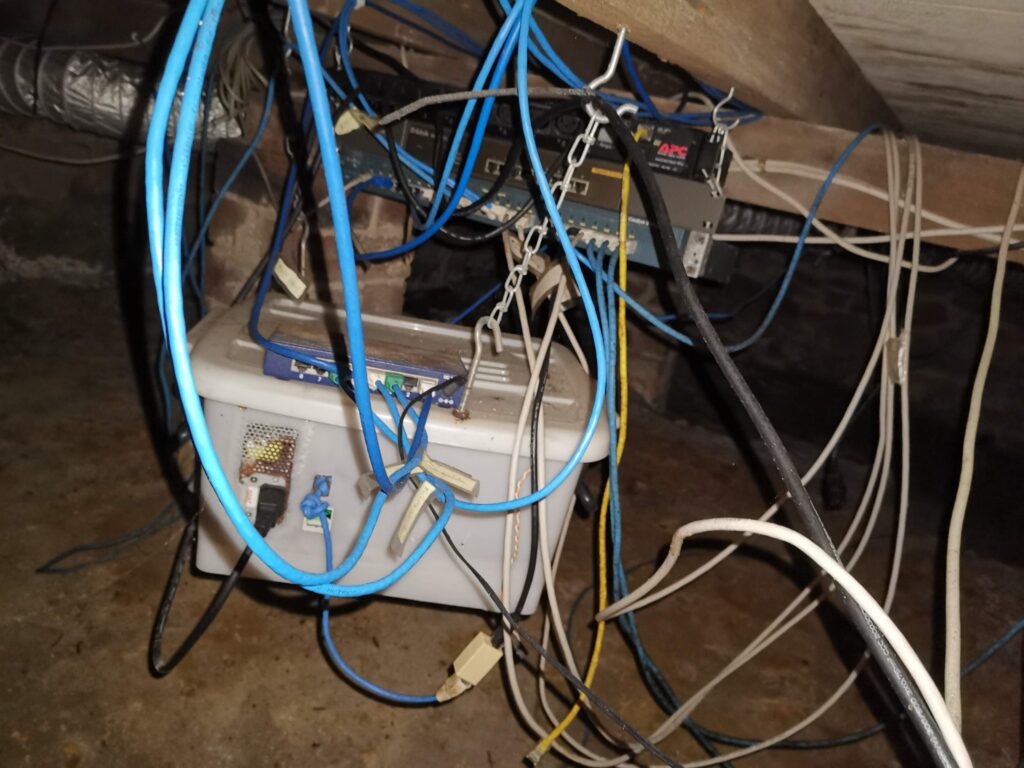Part of my personal lore is that I've enjoyed building PCs since forever, and because I was a student with limited funds for a long time, they've usually been modest affairs. I was never the rich kid with the latest CPU and GPU to enjoy games at high framerates, so it's always been firmly midrange affairs.
Anyway an offshoot of that was recognising that a computer that's always-on is really useful (we'd just call this a server now), and this was before we had nice modern power-efficient systems. Being somewhat noisy and bulky, it's ideal to tuck them somewhere out of the way where they're not a nuisance. That led to this thing, it's the cheapest and nastiest thing I could build and leave running 24/7.

I don't remember when I built it, but it's when I was living at my parents' place during uni. The little AMD Sempron sticker also dates it a bit, it's a "2200+" model which actually runs at 1500MHz. That puts it around no later then 2005 or so.
So what is this thing? It's the cheapest and nastiest box I could build, with some new parts from MSY and everything else scrounged from whatever I had lying around. It's low-power because that's the most appropriate thing for the environment - quiet and cool.
- Cheapest micro ATX motherboard, an ASrock K7S41GX, probably ~$90
- Probably an AMD Sempron 2200+, maybe... $100-120
- The motherboard had integrated graphics so I didn't need a GPU
- 384 MB of DDR-333 RAM that I had lying around (256MB+128MB sticks)
- Seagate 10gb PATA HDD (ST310212A) that I had lying around from other busted PCs
- PSU that I probably pulled out of an old desktop, likely 180 Watt rating or so
- Onboard 100Mbps networking
- Running Debian testing, which was probably "sarge" 3.1 at the time
- A plastic storage tub for a "case"
- There's an 80mm fan on the far side of the case for air intake
I'm sure that's not the most pressing question though - what's with the chains and wires and cables everywhere? Well my parents' house is an old place and it's built on brick piles, which means there's a big underfloor cavity that's perfect for this sort of thing.
Hanging the server from the joists was necessary to keep it off the ground, which is dirt that tends to get quite damp - the natural enemy of sensitive IT equipment like this. The same goes for the networking gear which is chained higher up.

I started with the Cisco switch (model WS-C2924-XL-EN) that was chucked out somewhere at uni, and later managed to add the remote-controllable powerboard (an APC AP7920) because it was disposed of from work. I think the D-Link came later because I wanted some gigabit ports, keeping in mind that the Cisco is only a 10/100Mbps switch.
I'm guessing the next question is "why would you need a 24-port switch under your house?". This was back in the day when wifi completely sucked, and 802.11g (54mbps) was extremely new, so you were definitely using 802.11b (11Mbps). Did I mention that this was a brick house? So there was no way you could get wifi to all the bedrooms, it would work terribly, if at all.
What did work great (and still does today) is wired ethernet. My brothers and I bought a 305-metre box of Cat5E and pulled it under the flooring so we could put ethernet ports in each room. And if you're gonna do this, you want ports everywhere to maximise the useful-ness. About a dozen ports, plus the server and PDU, and before you know it that switch is looking decently full.
I have a suspicion that the Cisco eventually succumbed to the damp environment and stopped working. That's why you can see another small desktop switch sitting on top of the server in the first photo.
Apart from that there's not much else to tell. I moved out with a flatmate a bit later on, but things kept ticking over decently for a while afterwards. That AP7920 PDU has been in production forever - they still sell them new today, albeit with a slightly revised "7920B" variant, and they still want to charge you $1500 for one. Absolutely nuts.